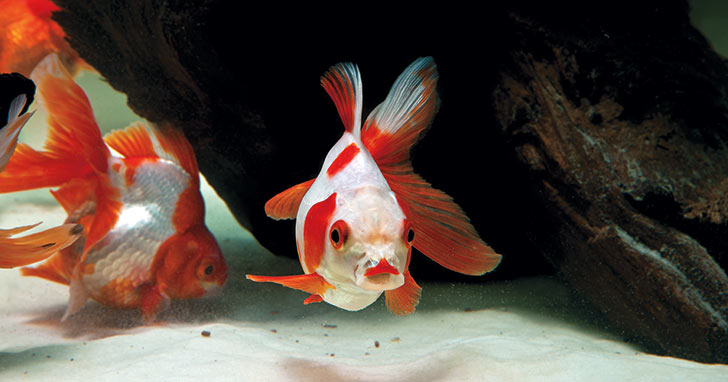
Today's aquarium filters offer a wide variety of options to keep your aquarium water clean and healthy. When choosing filtration, base your decision on the size of your aquarium, as well as number of fish you hope to keep. To achieve the absolute best water conditions, you may need to use more than one type of filter.
Air-driven Internal Filters
These small, inexpensive box-like or foam filters are ideal for rearing fry, hospital aquariums, and small aquariums with very small fish. They are strong enough to maintain good water conditions, yet gentle enough to keep small aquarium inhabitants free from harm. Most of these devices provide mechanical, chemical, and biological filtration. These filters are placed inside the aquarium and allow you to locate your aquarium very close to adjacent walls to save space.
Undergravel Filters
As their name suggests, these filters are placed underneath a layer of aquarium gravel. These filters move water through the gravel to create conditions favorable for biological filtration. Once the beneficial bacteria colonize the gravel, they begin to efficiently break down waste materials. Undergravel filters are relatively inexpensive and rely on either an air pump or powerhead to function. Undergravel filters are primarily biological filters. However, many models feature a replaceable cartridge placed at the end of the rigid tubing to provide supplementary chemical (activated carbon) or mechanical (filter floss) filtration. These filters are available for small or large aquariums but are best suited for aquariums with a light fish load.
Internal Power Filters
Imagine a power filter you can completely place underwater. These handy filters have the space-saving feature of air-driven internal filters and the power and versatility of standard power filters. These filters provide excellent filtration and water movement since they are generally placed near the bottom of the aquarium. Waste products are removed before they have a chance to settle on the bottom of the aquarium. They are made for smaller aquariums, generally under 20-gallons.
Power Filters
Power filters are probably the most widely used aquarium filters - and for good reason. They are very easy to use and provide excellent biological, chemical, and mechanical filtration. They are designed to hang off the back of your aquarium and are the perfect filter for most popular aquarium sizes housing a variety of tropical fishes. Replaceable filter cartridges make maintenance simple and convenient. Newer models feature either a biological filter pad or BIO-wheel to provide extra pollution removing power.
Canister Filters
Canister filters provide superior mechanical, chemical, and biological filtration for larger aquariums or aquariums with a lot of fish. The body or "canister" portion of the filter is significantly larger than most power filters - imagine how much media canister filters are able to hold! Depending on the model, canister filters will have one to three (or more) large media baskets to hold different filter media types. Each media type is layered on top of each other to maintain excellent water quality. Compared to power filters, canister filters require slightly more effort to set up and maintain. However, you will be amazed by their filtering power. These multipurpose filters are ideal for African and South American Cichlid aquariums, saltwater aquariums, as well as freshwater planted aquariums.
Wet/Dry Filters
Wet/dry filters provide the ultimate in biological filtration. They are great for saltwater fish-only aquariums or any large aquarium setup that demands efficient biological filtration. These filters are called wet/dry filters because the biological filter media is exposed to both aquarium water (wet) and a significant amount of air (dry). This design creates the ideal environment for large numbers of beneficial bacteria to actively process waste materials. In general, these aquarium filters require the most effort to set up since they need to be installed or plumbed to the aquarium in a rather elaborate manner. However, for the creative and avid aquarium hobbyist, setting up a wet/dry filter provides the ideal opportunity to construct a custom, one-of-a-kind filtration system. Most models are designed for placement under an aquarium and require an overflow box on the back. Most wet/dry filters include a sump/reservoir that holds auxiliary equipment along with the required water return pump.
Question:
Why do I need an aquarium filter? |
Answer:
Unlike natural aquatic systems, toxic compounds accumulate quickly in an enclosed aquarium system. Filters help create a healthy aquarium environment capable of supporting life. |
| Filter Type |
Cost
Range |
Setup Skill
Level |
Effectiveness:
Mechanical |
Effectiveness:
Chemical |
Effectiveness:
Biological |
Air-driven
Internal
Filters |
Low |
Basic |
Low |
Low |
Medium |
Undergravel
Filters |
Low-
Medium |
Basic |
Low |
Low |
Medium |
| Power Filters |
Low-
Medium |
Basic |
Medium |
Medium |
Medium |
Internal
Power Filters |
Low-
Medium |
Basic |
Medium |
Medium |
Medium |
Canister
Filters |
Medium-
High |
Intermediate |
High |
High |
Medium |
Wet/Dry
Filters |
High |
Advanced |
Medium |
Medium |
High |
|